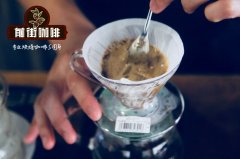Do you understand the "Golden Cup Rule"? how to flexibly adjust the ratio of powder to water when making coffee?

SCA identified seven basic elements of coffee extraction, and in my experience, one of the most basic elements is the most neglected. In fact, this is actually the first decision that people usually make when making coffee, whether they realize it or not. Of course, the variable is the ratio of coffee to water.
Whether you are a barista or a coffee lover, you may think about how much coffee you want to make when you buy a Hario V60 or a French kettle. I hope you are using a scale to measure the exact amount of coffee you want to use. The brewing scheme you use, whether carefully measured or unmoved, is the ratio of your coffee to water.
One of the main reasons why the ratio of coffee to water is important is that it largely determines which flavor combination is feasible. To understand the reason, please check the extraction control chart of SCA.

The X axis represents the yield or extraction rate of soluble matter. In essence, this is the percentage of coffee that dissolves during brewing and eventually enters the brewing process. The Y axis indicates the concentration or strength of the soluble matter. In other words, how much coffee do you actually have in the water?
Most coffee experts agree that when the concentration is 1.15-1.45%, the taste of filtered coffee is best between 18-22% soluble matter production. The box in the middle of the chart shows this possible strength and extraction range, often referred to as the "Golden Cup Standard". (it is worth noting that some industry leaders have recently argued that the amount of extraction should be more than 22%. )
Diagonals represent different brewing rates. They revealed that different extraction / strength combinations are only suitable for certain formulations. For example, only when the ratio of coffee to water is 1: 15:00 can 19% coffee be extracted with a modulation strength of 1.41. These figures are based on the average liquid retention rate. If you look closely, you can see that the 1:17 ratio is more likely to be "in the box" than other rates.
Important Notice :
前街咖啡 FrontStreet Coffee has moved to new addredd:
FrontStreet Coffee Address: 315,Donghua East Road,GuangZhou
Tel:020 38364473
- Prev

A brief introduction to the Ethiopian ECX trading system that manages the export of Ethiopian coffee
Ethiopia is the country where coffee was first discovered, and it is still the most important and best producer of coffee in terms of quality and output. Coffee is mostly traditional Arabica species, with an annual output of about 350000 tons and more than 70% of which are exported to countries around the world. About 15 million people in the country are engaged in coffee-related industries, and more than 90% of the farms or cooperatives are planted in small areas.
- Next

What does it mean to be a native species of coffee in Ethiopia's Sidama Guji region?
Forest coffee or wild-grown coffee trees are produced in the Sidamogugi region along the Mora Mora River in southern Ethiopia. The region also hosts many small coffee farms that pool coffee in cooperatives for grinding and export. The typical variety in the Guji region is the heirloom. it is important for us
Related
- Detailed explanation of Jadeite planting Land in Panamanian Jadeite Manor introduction to the grading system of Jadeite competitive bidding, Red bid, Green bid and Rose Summer
- Story of Coffee planting in Brenka region of Costa Rica Stonehenge Manor anaerobic heavy honey treatment of flavor mouth
- What's on the barrel of Blue Mountain Coffee beans?
- Can American coffee also pull flowers? How to use hot American style to pull out a good-looking pattern?
- Can you make a cold extract with coffee beans? What is the right proportion for cold-extracted coffee formula?
- Indonesian PWN Gold Mandrine Coffee Origin Features Flavor How to Chong? Mandolin coffee is American.
- A brief introduction to the flavor characteristics of Brazilian yellow bourbon coffee beans
- What is the effect of different water quality on the flavor of cold-extracted coffee? What kind of water is best for brewing coffee?
- Why do you think of Rose Summer whenever you mention Panamanian coffee?
- Introduction to the characteristics of authentic blue mountain coffee bean producing areas? What is the CIB Coffee Authority in Jamaica?

